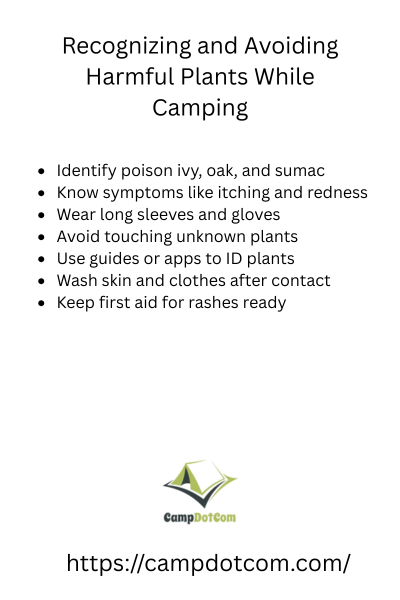Recognizing And Avoiding Harmful Plants While Camping isn’t just for hardcore survivalists—it’s something every camper should know, especially if you’d rather not spend your trip itching, burning, or, worse, heading to urgent care.
Let me tell you, I learned this the hard way.
Read More About Recognizing and Avoiding Harmful Plants While Camping

That One Time Poison Ivy Ruined My Weekend
A few summers ago, I went on a weekend camping trip with my cousin Josh. We found a beautiful and quiet spot away from the main trails with no other tents in sight, just trees, birds, and the gentle sound of a nearby stream. It felt like pure magic.
As an Amazon Associate, I earn from qualifying purchases. Some of the links in this article are affiliate links. This means that, at zero cost to you, I will earn an affiliate commission if you click through the link and finalize a purchase.
Or so I thought.
By the second day, I woke up with what I assumed were mosquito bites. That night, I was scratching my legs like there was no tomorrow. It turned out I had pitched our tent right next to a patch of poison ivy, and I had no idea. The rash lasted longer than the trip, and calamine lotion quickly became my closest companion.
So yes, learning how to recognize and avoid harmful plants while camping is absolutely worth it.
More Things to Know About Recognizing and Avoiding Harmful Plants While Camping

Why Bother Knowing These Plants?
If you’ve never run into poison ivy, oak, or sumac, you’re lucky. But even one run-in is enough to make you wish you had X-ray plant vision.
These sneaky plants blend right in. Some look downright harmless, while others grow around paths, water sources, or even your perfect tent spot. Recognizing and avoiding harmful plants while camping helps you dodge the drama—and keeps your trip fun, not itchy.
So, What Should You Watch Out For?
Let’s break it down simply. Here are a few of the usual suspects:
Poison Ivy – “Leaves of three, let it be.” They’re shiny, almond-shaped, and grow in clusters of three. Often found along trails and forest edges.
Poison Oak – Similar to poison ivy but bushier. The leaves can look a bit like oak leaves (hence the name).
Poison Sumac – This one’s trickier. It has 7–13 leaflets and grows in swampy areas. You probably won’t stumble into it unless you’re hiking through soggy ground.
All of them contain urushiol, a nasty oil that causes allergic reactions on your skin. And here’s the kicker—it lingers. Touch the plant, and then your gear, your clothes, or your face? The rash spreads.
How Can You Stay Safe?
Here’s what’s worked for me—and kept me rash-free ever since my poison ivy incident:
Do a plant ID refresher before each trip: Seriously, it only takes five minutes to Google photos of the usual suspects.
Wear long pants and sleeves: especially if you’re hiking off-trail. It’s not just about ticks—your skin needs protection from plants too.
Don’t trust every leafy green thing: If you’re unsure, don’t touch it. Treat it like it bites.
Wash your gear: when you get home. Urushiol can stick around on clothes, shoes, and backpacks for weeks.
Bring a rash treatment kit: Hydrocortisone cream, calamine lotion, and antihistamines can make a big difference if you mess up.
What If You Already Touched Something?
First things first—don’t panic. But act quickly.
Wash the area with soap and water as soon as you can. The faster you do this, the better your chances of removing the oil before it soaks in. Avoid scratching, no matter how tempting it gets. You’ll just spread the oil around more.
If the rash gets really bad, don’t try to tough it out. Get to a pharmacy or even a clinic. I once waited too long and ended up needing a prescription cream. Lesson learned.
Protect Your Skin by Learning to Spot Dangerous Plants
Recognizing and avoiding harmful plants while camping might not sound like the most exciting part of getting ready for your outdoor adventure, but it is far more enjoyable than dealing with a full body rash.
Camping should be about sunsets, campfire laughter, and sleeping under the stars, not ending up itchy and uncomfortable just because a plant looked pretty.
So next time you head out, take a moment to refresh your knowledge on those tricky plants. Your skin will thank you, and your trip will be memorable for all the right reasons.
Stay safe out there, and maybe bring along some calamine lotion just in case.
